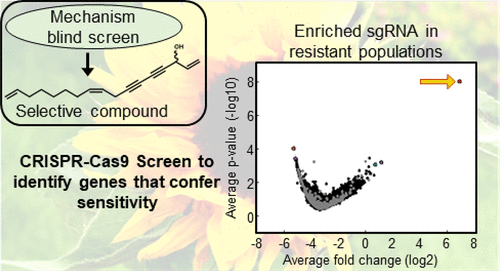当前位置:
X-MOL 学术
›
J. Nat. Prod.
›
论文详情
Our official English website, www.x-mol.net, welcomes your
feedback! (Note: you will need to create a separate account there.)
CRISPR-Cas9 Genome-Wide Knockout Screen Identifies Mechanism of Selective Activity of Dehydrofalcarinol in Mesenchymal Stem-like Triple-Negative Breast Cancer Cells
Journal of Natural Products ( IF 3.3 ) Pub Date : 2020-10-06 , DOI: 10.1021/acs.jnatprod.0c00642 Corena V Grant , Shengxin Cai 1 , April L Risinger , Huiyun Liang , Barry R O'Keefe 2 , John G Doench 3 , Robert H Cichewicz 1 , Susan L Mooberry
Journal of Natural Products ( IF 3.3 ) Pub Date : 2020-10-06 , DOI: 10.1021/acs.jnatprod.0c00642 Corena V Grant , Shengxin Cai 1 , April L Risinger , Huiyun Liang , Barry R O'Keefe 2 , John G Doench 3 , Robert H Cichewicz 1 , Susan L Mooberry
Affiliation

|
There are no targeted therapies available for triple-negative breast cancers (TNBCs) in part because they represent a heterogeneous group of tumors with diverse oncogenic drivers. Our goal is to identify targeted therapies for subtypes of these cancers using a mechanism-blind screen of natural product extract libraries. An extract from Desmanthodium guatemalense was 4-fold more potent for cytotoxicity against MDA-MB-231 cells, which represent the mesenchymal stem-like (MSL) subtype, as compared to cells of other TNBC subtypes. Bioassay-guided fractionation led to the isolation of six polyacetylenes, and subsequent investigations of plant sources known to produce polyacetylenes yielded six additional structurally related compounds. A subset of these compounds retained selective cytotoxic effects in MSL subtype cells. Studies suggest that these selective effects do not appear to be due to PPARγ agonist activities that have previously been reported for polyacetylenes. A CRISPR-Cas9-mediated gene knockout screen was employed to identify the mechanism of selective cytotoxic activity of the most potent and selective compound, dehydrofalcarinol (1a). This genomic screen identified HSD17B11, the gene encoding the enzyme 17β-hydroxysteroid dehydrogenase type 11, as a mediator of the selective cytotoxic effects of 1a in MDA-MB-231 cells that express high levels of this protein. The Project Achilles cancer dependency database further identified a subset of Ewing sarcoma cell lines as highly dependent on HSD17B11 expression, and it was found these were also highly sensitive to 1a. This report demonstrates the value of CRISPR-Cas9 genome-wide screens to identify the mechanisms underlying the selective activities of natural products.
中文翻译:

CRISPR-Cas9全基因组敲除筛选鉴定了间充质干细胞样三阴性乳腺癌细胞中脱氢falcarinol选择性活性的机制
目前尚无针对三阴性乳腺癌 (TNBC) 的靶向治疗,部分原因是它们代表了具有不同致癌驱动因素的异质性肿瘤组。我们的目标是使用天然产物提取物库的机制盲筛选来确定这些癌症亚型的靶向治疗。与其他 TNBC 亚型的细胞相比,危地马拉Desmanthodium guatemalense提取物对代表间充质干细胞 (MSL) 亚型的 MDA-MB-231 细胞的细胞毒性强 4 倍。生物测定引导的分馏分离出六种聚乙炔,随后对已知产生聚乙炔的植物来源的研究产生了另外六种结构相关的化合物。这些化合物的一部分在 MSL 亚型细胞中保留了选择性细胞毒性作用。研究表明,这些选择性作用似乎并非由先前报道的聚乙炔的 PPARγ 激动剂活性所致。采用 CRISPR-Cas9 介导的基因敲除筛选来鉴定最有效和最具选择性的化合物——脱氢黄钊醇 ( 1a ) 的选择性细胞毒活性机制。该基因组筛选鉴定了HSD17B11 (编码11型17β-羟基类固醇脱氢酶的基因)作为1a在表达高水平该蛋白的MDA-MB-231细胞中选择性细胞毒性作用的介体。 Project Achilles 癌症依赖性数据库进一步鉴定出尤文肉瘤细胞系的一个子集高度依赖HSD17B11表达,并且发现这些细胞系对1a也高度敏感。 该报告展示了 CRISPR-Cas9 全基因组筛选对于识别天然产物选择性活性机制的价值。
更新日期:2020-10-26
中文翻译:

CRISPR-Cas9全基因组敲除筛选鉴定了间充质干细胞样三阴性乳腺癌细胞中脱氢falcarinol选择性活性的机制
目前尚无针对三阴性乳腺癌 (TNBC) 的靶向治疗,部分原因是它们代表了具有不同致癌驱动因素的异质性肿瘤组。我们的目标是使用天然产物提取物库的机制盲筛选来确定这些癌症亚型的靶向治疗。与其他 TNBC 亚型的细胞相比,危地马拉Desmanthodium guatemalense提取物对代表间充质干细胞 (MSL) 亚型的 MDA-MB-231 细胞的细胞毒性强 4 倍。生物测定引导的分馏分离出六种聚乙炔,随后对已知产生聚乙炔的植物来源的研究产生了另外六种结构相关的化合物。这些化合物的一部分在 MSL 亚型细胞中保留了选择性细胞毒性作用。研究表明,这些选择性作用似乎并非由先前报道的聚乙炔的 PPARγ 激动剂活性所致。采用 CRISPR-Cas9 介导的基因敲除筛选来鉴定最有效和最具选择性的化合物——脱氢黄钊醇 ( 1a ) 的选择性细胞毒活性机制。该基因组筛选鉴定了HSD17B11 (编码11型17β-羟基类固醇脱氢酶的基因)作为1a在表达高水平该蛋白的MDA-MB-231细胞中选择性细胞毒性作用的介体。 Project Achilles 癌症依赖性数据库进一步鉴定出尤文肉瘤细胞系的一个子集高度依赖HSD17B11表达,并且发现这些细胞系对1a也高度敏感。 该报告展示了 CRISPR-Cas9 全基因组筛选对于识别天然产物选择性活性机制的价值。











































 京公网安备 11010802027423号
京公网安备 11010802027423号